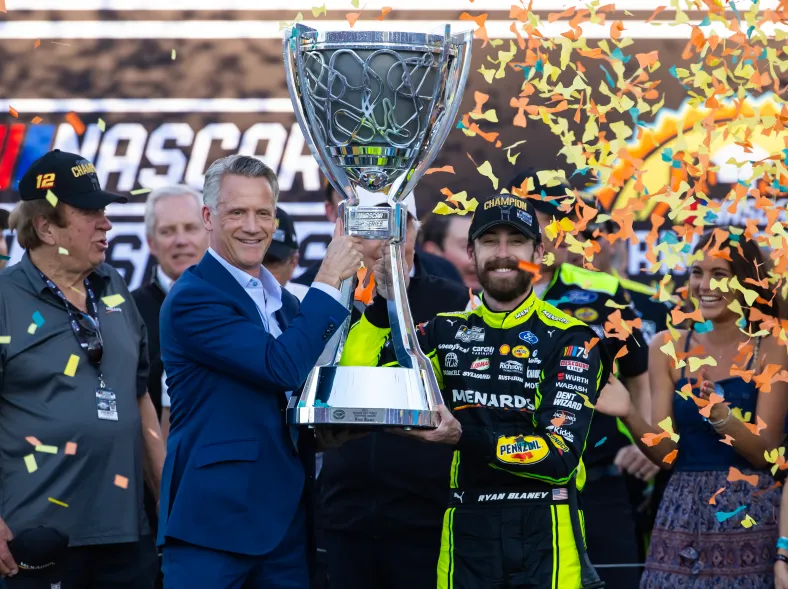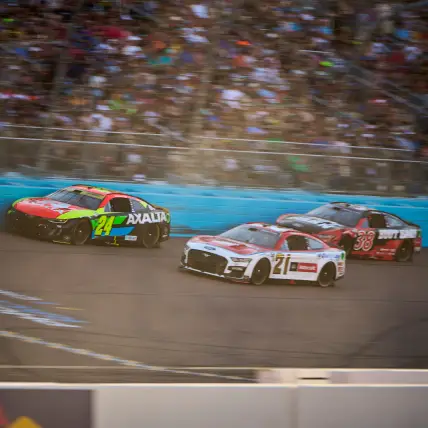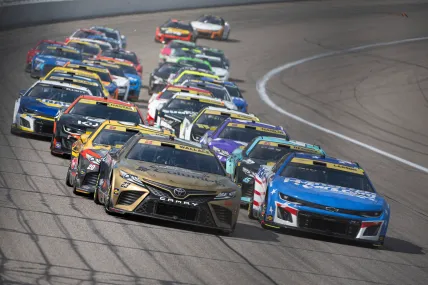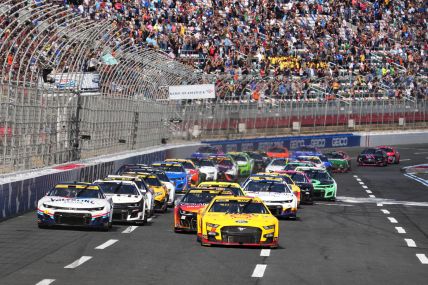
According to a report in the Sports Business Journal, NASCAR and the teams that compete in the Cup Series have extended their negotiating window over a new financial structure through the end of the month.
The sanctioning body inked a seven-year agreement with FOX Sports, NBC Sports, Amazon’s Prime Video and TNT Sports that will reportedly pay over $1.1 billion per season starting in 2025. Combined with a previously announced agreement with the CW Network to air the Xfinity Series over that same length, NASCAR netted 7.7 billion on its broadcast rights.
That a deal came together much later than NASCAR would have preferred also held up the negotiating process with the teams over its financial structure running the length of the agreement. Right now, 65 percent of the broadcast money goes to the tracks, 25 percent goes to the teams and 10 percent goes to NASCAR itself.
The SBJ says team actually get closer to 39 percent of the television revenue when factoring prize money.
That agreement also runs through the life of the current television rights agreement with FOX and NBC that runs through the end of the year. The negotiating window ended at the end of 2023 but NASCAR extended it through January in the hopes that a deal can be struck before it becomes a distraction once the season starts in February.
Some teams were hoping for closer to 45% while some proponents of teams have said that ideally the split should be 50-50. This year, teams are expected to be paid nearly $210M in media rights income, according to information reviewed by SBJ, though there is also track promoter fees and a contribution from NASCAR that add into a larger total, which couldn’t be learned.
Sports Busines Journal

How the NASCAR charter system works
The other component to the agreement is NASCAR’s charter system.
Charters are effectively NASCAR’s version of a franchise. It’s not an apples-to-apples comparison, but the Hendrick Motorsports No. 24 and Team Penske No. 2 are motorsport equivalents to the Los Angeles Dodgers and New York Yankees.
In the same way that leagues and teams enter into revenue-sharing agreements across multiple sports, NASCAR and Cup Series teams have a similar deal in the charter system. There are 36 charters and each one permits automatic entry into every Cup Series race and provides anywhere from $5-10 million per season depending on performance.
Cup races start up to 40 cars per race, but the unchartered cars that make the show receive considerably less revenue compared to those that are franchised.
The Cup Series teams are represented by an entity called the Race Team Alliance, who wants to make the charter agreement permanent, but NASCAR has not formally agreed to that model yet.
So what happened if a deal isn’t reached by the end of the 2024 season? It’s basically a doomsday scenario, no matter how unlikely the outcome would actually be.
If no deal is reached, technically, NASCAR would then be able to seize charters and teams would be able to look into starting or joining rival racing series, two key things they’re typically barred from doing under the terms of the current system. Teams and NASCAR also need to sort out how the money will be split among the 36 chartered cars. Currently there are four sources that contribute to how much a team gets in a given year for its charter: race purse; a fixed owner’s plan; a historical owner’s plan; and a year-end points fund. Those represent a mixture of fixed amounts that each team gets along with varying amounts that depend on how a team has performed on track that year and in recent seasons.
Sports Business Journal
In layman’s terms, the teams that currently comprise the NASCAR Cup Series would be legally free to start their own series with their drivers and crews racing independently of the series that has defined Stock Car racing in the United States since 1948.
It’s also something that the race teams have legitimate considered.
Through its involvement in broadcasting grassroots races on the Racing America streaming platform, a vertical the race teams collectively own, the Race Team Alliance has no shortage of strategic partnerships with cars, tracks and sanctioning bodies that could be the foundation of such a move.
Or at least as the foundation of a negotiating tactic to threaten such a move.
From a historical standpoint, NASCAR is arguably only the top motorsports brand in North America because something like this actually happened to Indy car racing throughout the 80s and 90s, culminating with the open wheel split.
In 1979, Indy car team owners broke away from the United States Auto Club (USAC) and formed Championship Auto Racing Teams and governed themselves as a sanctioning body while running its marquee event at the Indianapolis Motor Speedway, the legendary Indianapolis 500.
In time, the Indianapolis Motor Speedway formed its own series, the Indy Racing League in 1994 to begin competition by 1996 and rising tensions led to CART teams boycotting the Indianapolis 500. In fact, CART and all the major teams and drivers of open wheel racing attempted to form an alternative to the Greatest Spectacle in Racing, the United States 500 at Michigan International Speedway in 1996.
The short version of that story is that CART and IRL both ran rival series for 12 years with most CART teams eventually migrating away from what was eventually rechristened the Champ Car World Series back to the Indianapolis 500 and the IRL.
Champ Car folded into the IRL by 2008 to become what is now the modern IndyCar Series but the damage was done and NASCAR became a cultural phenomenon in the 90s, in part by racing at the Indianapolis Motor Speedway themselves in the Brickyard 400.
Everyone involved in the NASCAR and Race Team Alliance negotiations know their history and what’s at stake.
Ultimately, the teams want to be more financially stable and NASCAR will want to get the best deal it can for itself while also protecting its hegemony in North American motorsports. NASCAR has also invested its television revenue into modernizing facilities like Daytona, Talladega, Richmond and Phoenix.
It has invested into its own future with events like the Clash at the Los Angeles Memorial Coliseum and the Chicago Street Race.
The charter system has been a net positive for the teams in terms of an inherent value that has went from single digit millions of dollars to the latest purchase, Live Fast selling to Spire, costing a reported $40 million.
The Next Gen car, which will soon begin its third year, is meant to eventually become something closer to a fixed cost since it is a single source supplied spec car that doesn’t allow team to R&D and manufacture increasingly expensive parts.
That car continues to evolve, from both a safety and competition standpoint, so it’s not where the whole industry would like it to be from a cost containment standpoint. Some teams, including Denny Hamlin publicly, as suggested that teams could save money by building specific parts themselves.
In other words, each team would be tasked with a specific component and send them to NASCAR, where the parts would be certified and disseminated to their respective teams for competition.
With a car that has its components purchased from single source suppliers, teams have laid off numerous employees since they are no longer doing the work themselves. The teams say they are still operating at a loss and the sanctioning body had previously told teams they needed to be leaner still.
What else is there to cut has been the frequent rebuttal.
Surely, that’s part of the negotiation process taking place right now too.
NASCAR currently has a deal with all its partner vendors, who each won a bid to produce the parts, that runs through the end of the 2024 season. If you notice the trend of everything running through 2024, that’s by design, as the entire fiscal foundation of the sport is held together by the broadcast rights.
So any major change to the car from both a short track competition standpoint or even a team cost-containment standpoint will also be determined by the recently extended charter negotiations window.
Matt Weaver is a Motorsports Insider for Sportsnaut. Follow him on Twitter.

